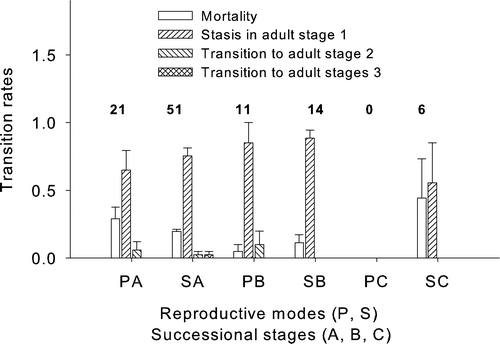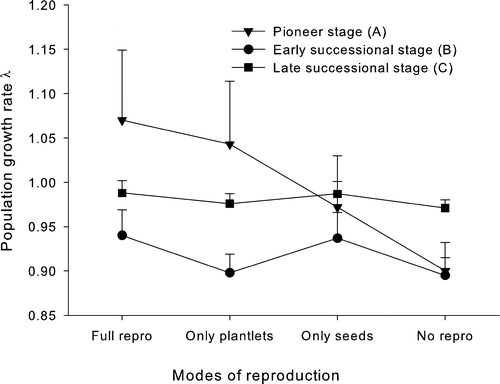Figures & data
FIGURE 1 Mean monthly soil temperatures at a depth of 10 cm for the three successional stages (pioneer, early, late) of the Rotmoos glacier foreland from 2004 to 2006 (data: Rüdiger Kaufmann).

FIGURE 2 Ratios of plantlet and seedling fecundities as a function of successional stage. White bars—inflorescence fecundity ratio f IP/f IS averaged over small and large individuals; hatched bars—ratio between reproducing individuals with either plantlets or seeds (n P/n S); black bars—net fecundity ratio f NP/fNS.
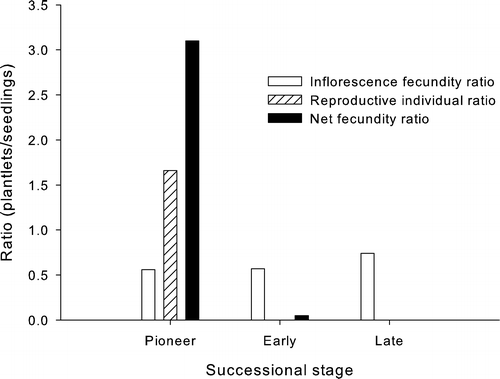
TABLE 1 Inflorescence fecundities f IP and f IS (number of plantlets or seeds per inflorescence) in dependence on successional stage. The numbers in parentheses give sample sizes. Small individuals: 2–5 shoots, large individuals: >5 shoots.
TABLE 2 Inflorescence frequencies n IP and n IS (numbers of pseudoviviparous and seminiferous inflorescences) per individual in dependence on successional stage (mean values and standard deviations). The numbers in parentheses give individual sample sizes. For the definition of small and large individuals see .
TABLE 3 Numbers of individuals with generative shoots producing either plantlets (n P) or seeds (n S) in the three permanent plots of the pioneer stage A. The numbers in parentheses give the numbers of individuals being present in 2006 as well as in 2009 showing the same reproductive mode.
FIGURE 3 Number of established plantlets (a) and seedlings (b) per adult individual (net fecundity values f NP and f NS) vs. shoot density, successional stage, and year of transition. The number of new plantlets and seedlings, respectively, in year t + 1 per plot were related to the number of adults (individuals with 1 or more shoots) in year t in the same plot, and these ratios are plotted against the total number of shoots per plot in year t. Successional stages are denoted by symbols (triangle: pioneer stage; circle: early successional stage; square: late successional stage). Closed symbols: transition 2004–2005, open symbols: transition 2005–2006.
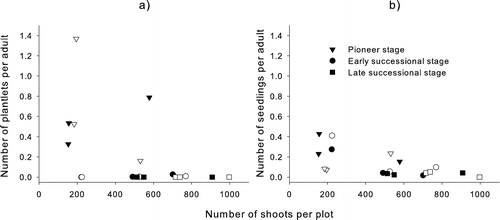
FIGURE 4 Transition rates (mean values and standard errors) for plantlets P and seedlings S in dependence on successional stage (pioneer stage A, early successional stage B, late successional stage C). The rates in each group average over 3 plots per stage and two transitions. The numbers on the bars denote the average number of seedlings or plantlets per plot entering into the calculation of rates.
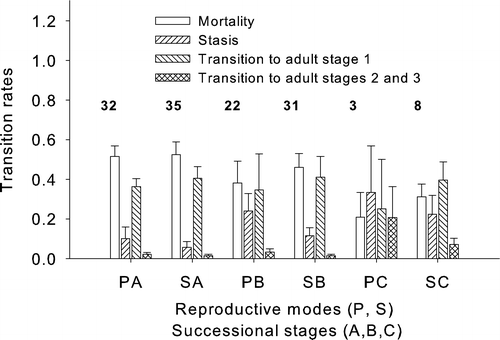
FIGURE 5 Transition rates (mean values and standard errors) for one-shoot adults originating in the preceding step from plantlets P or seedlings S, respectively, as a function of successional stage (see legend to ). The rates in each group are averaged over three plots per stage. The numbers on the bars denote the number of individuals per stage entering into the calculation of rates.
